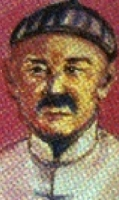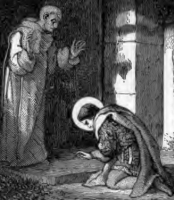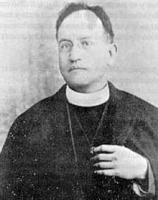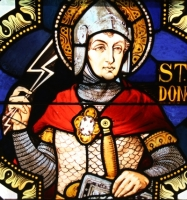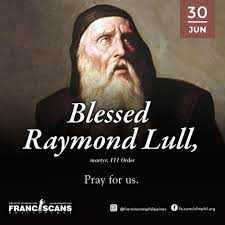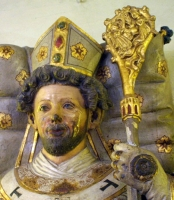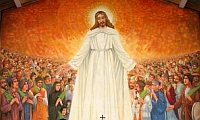St. Felix of Como
Feastday: July 1
Death: 390
First bishop of Como, Italy. He was a friend of St. Ambrose.
Saint Felix of Como (died on October 8, 391 AD) is venerated as the first bishop of Como.
He was a friend of Saint Ambrose, who praised him for his missionary activity and ordained him a priest in 379 and a bishop in 386. When Bassianus of Lodi built a church dedicated to the Apostles at Lodi, he consecrated it in the presence of Ambrose and Felix.
Felix is honored as a zealous pastor of souls. His feast day is July 1
Feast of the Most Precious Blood of Our Lord Jesus Christ
Article
Celebrates the Blood of Our Saviour, shed for the redemption of mankind, mentioned repeatedly in the New Testament. Since the Council of Trent theologians generally hold that it was an essential part of the Sacred Humanity and consequently hypostatically united to the Second Person of the Blessed Trinity and therefore an object of adoration. Although special honour was bestowed upon it by the Apostles and Fathers and many saints, yet a feast in its honour was not celebrated till the beginning of the 19th century, when Saint Gaspare del Bufalo obtained permission to have it celebrated in the Missionary Society of the Precious Blood. Pope Blessed Pius IX extended the feast to the entire Church in 1849. There has been an arch-confraternity of the Precious Blood since 1815.
Blessed Nazju Falzon
புனித இக்னேசியஸ் பால்சோன் (St.Ignatius Falzon)
திருத்தொண்டர்
பிறப்பு
1813
மால்டா
இறப்பு
01 ஜூலை 1875
புனிதர்பட்டம்: 1905, திருத்தந்தை 10ஆம் பயஸ்
இவர் குழந்தை பருவத்திலிருந்தே மிகவும் பக்தியானவராக வளர்ந்தார். தினமும் ஜெபமாலை செபிப்பதில் வல்லவராக திகழ்ந்தார். இவர் தனது உயர் கல்வியை முடித்தபின் குருமடத்திற்கு சென்றார். ஆனால் குருவாவதற்கான வயதையும், தகுதியும் இவரிடம் இல்லாமல் இருந்தது. இதனால் தன் வாழ்நாள் முழுவதும் இவர் ஓர் ஆன்ம வழிகாட்டியாக பணிபுரிந்தார். இவர் குழந்தைகளுக்கும், இளைஞர்களுக்கும் ஞான உபதேசம் கற்றுக்கொடுப்பதிலும், அடிக்கடி மால்டா தீவிற்கு சென்று, அங்கிருந்து ஆங்கிலேயே படைவீரர்களுக்கு திருவருட்சாதனங்களைப் பற்றி கற்றுக்கொடுப்பதிலும் தன் நாட்களை கழித்தார். போர் வீரர்கள் மனந்திரும்பி கிறிஸ்துவை ஏற்றுக்கொண்டு, விசுவாசத்தில் வளர வழிகாட்டினார். இவர்களின் உதவியினாலும், 600 படைவீரர்களைக்கொண்டு, வாலெட்டாவில் ஓர் சபையை தொடங்கினார்.
காலைமுதல் மாலைவரை உழைத்து முடித்துபின், நாளுக்கு நன்றி கூறியும், அந்நாளில் செய்த பாவத்திற்கு பாவமன்னிப்பும் வேண்டி ஒவ்வொரு நாள் மாலையும் வழிபாடு நடத்தப்பட்டது. உலகின் பாவங்களுக்காக அனைவரும் சேர்ந்து செபித்துக்கொண்டிருக்கும்போது, தன் கைகளைவிரித்து, கண்களை மேலே உயர்த்தியவாறு, தன் ஆன்மாவை இறைவனிடம் கையளித்தார்.
Also known as
Ignatius Falzon
Profile
Son of Francis Joseph, a judge, and Mary Teresa, the daughter of judge. Ignatius and all three of his brothers became lawyers; two of his brothers entered the priesthood. Ignatius received minor orders at age 15. He earned a degree in theology, but did not feel worthy of the priesthood, and though his bishop encouraged him, Ignatius never took the final step of becoming ordained. Taught catechism to children at the Institute of the Good Shepherd; known to help the poorer children with money, as well.
Worked with the British soldiers and sailors stationed on Malta, meeting them by hanging around the docks and other places where they were assigned. They were rough men in a rough district of bars and and prostitutes, but when Ignatius found those who interested in the faith, he brought to his own home for services. When more and more men grew interested, he moved them to the Jesuit Church in Valletta, Malta. To explain the faith, he imported simple religious works in assorted vernacular languages, and distributed them to the men. Wrote The Comfort of the Christian Soul. He converted hundreds, and for those who stayed on the island, he became their pastor, performed their marriages, baptized their children, said homilies at their funerals.
Born
1 July 1813 at Valletta, Malta
Died
• 1 July 1865, Valletta, Malta of cancer
• buried in the family vault in the Chapel of the Immaculate Conception in the Church of the Franciscan Minors, Mary of Jesus in Valletta
Beatified
• 9 May 2001 by Pope John Paul II
• beatification miracle involved the complete disappearance of cancer in 64 year old man in 1981
Saint Oliver Plunkett
Also known as
Oileabhéar Pluincéad
Profile
Oliver was born to the Irish nobility, part of a family who supported King Charles I and the fight for Irish national freedom from England. Growing up, he was greatly influenced by his uncle Patrick, a Cistercian monk who later became bishop of the Irish dioceses of Ardagh and Meath. Beginning in 1647, Oliver studied at the newly established Irish College in Rome, Italy, an institute operated by the Jesuits. He was ordained a priest in Rome in 1654. He loved the city of Rome and stayed there to serve as professor of theology at the Propaganda Fide College from 1654 through 1669, and part of the time as procurator or agent in Rome for the bishops of Ireland. In 1669 Father Oliver was chosen archbishop of Armagh, Ireland, making him the primate, or primary Church official, of all Ireland.
Bishop Oliver's return to Ireland was a rough one; discipline was lax among the priests, and many clergy and laity were so provincial that they objected to a man from County Meath becoming bishop in Armagh. Oliver worked to return the faithful to the faith, and his diocese to their support. He established the Jesuits in Drogheda, where they ran a school for boys, and a college for theology students. He enforced clerical discipline and worked to send students to the colleges in Rome. He extended his ministry to Gaelic speaking Catholics of the highlands and the isles off the coast of Ireland, but due to a increase in the persecution of Catholics, he was forced to conduct much of his ministry covertly.
Saint Oliver was arrested and at Dundalk, Ireland in 1679 on a charge of conspiring against the state as part of the "Titus Oates" plot to overthrow King Charles II. He was initially lodged at Dublin Castle where he gave final absolution to Archbishop Peter Talbot of Dublin. Oliver was accused to taxing the clergy to pay for 70,000 men, 20,000 of whom would be French soldiers that the bishop would bring into the country. The English authorities knew that Oliver would never be convicted in Ireland, and had him moved to Newgate prison in London, England. His first trial was an aquittal, but he was not released. Instead, a second trial was arranged, and it was complete kangaroo court; Lord Campbell, writing of the judge, Sir Francis Pemberton, called it a disgrace to himself and his country. Plunkett was found guilty of high treason "for promoting the Catholic faith," and was condemned to a gruesome death. He was the last Catholic to die for his faith on the gallows at Tyburn in London, and was the first of the Irish Martyrs to be beatified.
Born
30 September 1629 at Loughenew, County Meath, Ireland
Died
• hanged, drawn, and quartered on 1 July 1681 at Tyburn, England
• body initially buried in two tin boxes next to five Jesuits who had died before him
• his head is in Saint Peter's Church at Drogheda, Ireland
• most of his body is at Downside Abbey, Somerset, England
• some relics in other churches in Ireland
Canonized
12 October 1975 by Pope Paul VI at Rome, Italy
Patronage
archdiocese of Armagh, Ireland
Saint Junipero Serra
புனித ஜுனிபெரோ செர்ரா (ஜூலை 01)
“என் வாழ்நாள் முழுக்க நான் ஒரு நற்செய்திப் பணியாளராகவே வாழ ஆசைப்பட்டேன். ஏனென்றால் கிறிஸ்துவைக் குறித்தும் அவர் அறிவித்த நற்செய்தியைக் குறித்தும் அறியாமல் பலர் இருக்கிறார்கள். அவர்களுக்கு நற்செய்தி அறிவிப்பதை நான் பெற்ற பேறுபலனாகக் கருதுகிறேன்” – ஜூனிபெரோ செர்ரா
வாழ்க்கை வரலாறு
இன்று நாம் நினைவுகூரும் ஜூனிபெரோ செர்ரா, 1713 ஆம் ஆண்டு, ஸ்பெயின் நாட்டில் உள்ள மஜோர்கா என்னும் இடத்தில் பிறந்தார். இவர் வளர்ந்து தன்னுடைய தொடக்க கல்வியை பால்மா என்னும் இடத்தில், பிரான்சிஸ்கன் சபை துறவிகள் நடத்தி வந்த பள்ளியில் கற்றார். அப்போதே இவருக்கு ஒரு குருவாக மாறி, ஆண்டவருடைய நற்செய்தியை எல்லா மக்களுக்கும் எடுத்துரைக்கவேண்டும் என்னும் எண்ணம் உண்டானது. எனவே இவர் குருமடத்தில் சேர்ந்து, குருவாகப் படிக்கத் தொடங்கினார். 1736 ஆம் ஆண்டு குருவாகவும் உயர்ந்து நின்றார்.
குருவாக மாறியபின்பு பல இடங்களுக்குச் சென்று, ஆண்டவரின் நற்செய்தியை அறிவிக்கலாம் என்று கனவுகண்டிருந்த இவருக்கு, குருமடத்தில் பேராசிரியராகப் பணியாற்றவேண்டும் என்று சொல்லப்பட்டதும் மனம் உடைந்து போனார். இருந்தாலும் இதனை அவர் இறைத்திருவுளமாக ஏற்றுக்கொண்டு, குருமாணவர்களுக்கு நல்லவிதமாய் பாடம் கற்றுக்கொடுக்கத் தொடங்கினார். ஏறக்குறைய பதிமூன்று ஆண்டுகள் இவர் குருமாணவர்களுக்கு பாடம் சொல்லிக்கொடுத்த பின்பு, முன்பு இவர் கண்ட கனவு நனவாகத் தொடங்கியது. ஆம், இவருக்கு நீயூ மெக்கிசிக்கோவிற்கு நற்செய்தியை அறிவிக்கக்கூடிய அழைப்பு வந்தது. உடனே இவர் எந்தவொரு மறுப்பும் சொல்லாமல் அங்கு நற்செய்தியை அறிவிக்கப் புறப்பட்டுச் சென்றார்.
புதிய இடம், புதிய பணி, புதிய மனிதர்கள் இவையெல்லாம் ஒருபக்கம் இருந்தாலும் ஜூனிபெரோ செர்ரா ஆர்வத்தோடு நற்செய்திப் பணியை செய்யத் தொடங்கினார். இதனால் பலர் திருமுழுக்குப் பெற்று கிறிஸ்தவர்களாக வாழத் தொடங்கினார்கள். ஏறக்குறைய ஒன்பது ஆண்டுகள் நீயூ மெக்கிசிக்கோவில் பணியாற்றிய ஜூனிபெரோ செர்ரா, அதன்பிறகு கலிபோனியாவிற்குச் சென்று நற்செய்தியை அறிவிக்கத் தொடங்கினார். இங்கேயும் இவர் பலரை கிறிஸ்தவ மறைக்குள் கொண்டுவந்து சேர்த்தார்.
ஜூனிபெரோ செர்ரா, தன்னுடைய நற்செய்திப் பணிவாழ்வில் பல செவ்விந்தியர்களைச் சந்தித்தார். அவர்களுக்கும் இவர் ஆண்டவரின் நற்செய்தியை ஆர்வத்தோடு அறிவித்தார். ஒருசில இடங்களில் இவர் பிரச்சனைகளையும் சந்தித்தார். அந்தப் பிரச்சனைகளைக் கண்டு இவர் மனம் தளர்ந்து போய்விடாமல் துணிவோடு நற்செய்தியை அறிவித்து வந்தார்.
இவர் அடிக்கடி சொள்ளக்கூடிய வார்த்தைகள் ‘Always Forward, Never Backward’ என்பதாகும். அதாவது இவர் முன் வைத்த காலை, பின்வைக்கக் கூடாது என்பதை வேதவாக்காகக் கொண்டு வாழ்ந்து வந்தார். இத்தகையதொரு ஆர்வமிக்க நற்செய்திப் பணியாளரான ஜூனிபெரோ செர்ரா நோய்வாய்ப்பட்டு, படுத்தபடுக்கையாகி, 1784 ஆம் ஆண்டு இறையடி சேர்ந்தார். இவருக்கு 1988 ஆம் ஆண்டு திருத்தந்தை இரண்டாம் யோவான் பவுல் அவர்களால் அருளாளர் பட்டம் கொடுக்கப்பட்டது.
Also known as
• Apostle of California
• Miguel José Serra Ferrer
Additional Memorial
1 July (United States)
Profile
Entered the Franciscan University at Palma, Spain at age 15, and joined the Order at age 17, taking the name Junipero after the friend of Saint Francis. Ordained in 1737, and taught philosophy and theology at the Lullian University.
In 1749, Serra was sent to the missionary territories of the west of North America. A mosquito bite he received early in his trip to the New World left one leg swollen; this and his asthma made walking a painful process for the rest of his life. In 1768 he took over missions in the Mexican provinces of Lower and Upper California, missions the Jesuits were forced to abandon by order of King Charles III. A tireless worker, Serra was largely responsible for the foundation and spread of the Church on the West Coast of the United States. Founded twenty-one missions, converted thousands of Native Americans, and trained many of them in European methods of agriculture, cattle husbandry, and crafts. Dedicated religious and missionary, penitent and austere in all areas of his life.
Blessed Junipero Serra is the namesake of the Serra Club, an international Catholic organization dedicated to the promotion of vocations, and the support of seminarians and religious novices. Many of his letters and other writings have survived, and the diary of his travels to the west was published in the early 20th century.
Born
24 November 1713 at Petra, Spanish Majorca as Miguel Jose Serra
Died
• 28 August 1784 of tuberculosis at Mission San Carlos, California of natural causes
• buried at Carmel, Monterey, California
Canonized
• 23 September 2015 by Pope Francis
• canonization recognition celeberated at the Basilica of the Immaculate Conception, Washington, DC, presided by Pope Francis
Blessed Antonio Rosmini-Serbati
Profile
Educated at home, and then three years at the University of Padua, Italy. Ordained on 21 April 1821 at Chioggia, Italy. Received his Doctorate of Canon Law and Theology in 1822. Began work in Rome, Italy in 1823, studying philosphy for the next three years, especially the works of Saint Thomas Aquinas. He taught that the human mind is endowed with an innate cognition, the single conception of ideal being, a mental form, a condition of knowledge and the light of reason. Founded the Institute of Charity (Rosminians) and the Rosminian Sisters of Providence in 1828, which by 1835 were conducting missions in Italy and England; the congregation is devoted to education and charity. His ontology and natural theology and his Trattato della Coscienza of 1839 were severely criticized; forty of his propositions were eventually condemned by the Congregation of the Inquisition in 1887. Appointed by Blessed Pope Pius IX as one of the consultors to deliberate on the doctrine of the Immaculate Conception.
Born
24 March 1797 in Rovereto, Austrian Tyrol (modern Trent, Italy)
Died
• 1 July 1855 in Stresa, Viterbo, Italy of natural causes
• interred in the Church of the Santissimo Crocifisso built by him in Stresa
Beatified
18 November 2007 by Pope Benedict XVI
Works
• Cinque piaghe della chiesa (1848)
• Costituzione secondo la giustizia sociale (1848)
• Dell' Educazione Cristiana
• Maxims of Christian Perfection
• Nuovo saggio sull' origine delle idee (Origin of Ideas)
• Trattato della coscienza morale (1839)
Blessed Assunta Marchetti
Profile
One of eleven children. Nun. Co-founder the Missionaries of Saint Charles Borromeo (Scalabrinian Sisters) whose 800 sisters continue their work today in 26 countries.
Born
15 August 1871 at Lombrici di Camaiore, Lucca, Italy
Died
1 July 1948 in São Paulo, Brazil
Beatified
• 25 October 2014 by Pope Francis
• her beatification miracle involved the rapid, instantaneous, and permanent healing of Heraclides Teixeira Filho of "ischemic heart disease, cardiac arrest during the myocardial revascularization, dissection of cornary dx, cardio-surgical intervention of the myocardial revascularization in emergency conditions" in January 1994 at the Hospital Mãe de Deus in Porto Alegre, Brazil
• beatification recognition celebrated in São Paulo, Brazil, celebrated by by Cardinal Angelo Amato and Cardinal Odilo Scherer
Blessed Thomas Maxfield
Also known as
Thomas Macclesfield
Memorial
29 October as one of the Martyrs of Douai
Profile
Son of Ursula and William Macclesfield; his father was later charged with hiding and supporting priests, one of which was Thomas's brother, Father Humphrey. Thomas studied at the English College in Douai, France; ordained in 1614. In 1615 he returned to England to minister to covert Catholics. He was soon arrested for the crime of being a priest. After eight months he tried to escape, but was caught and moved to Newgate prison; there he ministered to other prisoners and brought some to the faith. Went to trial on 26 June 1616 for the crime of priesthood, was found guilty, and sentenced to death. A group of Catholic Spaniards acted as an honour guard as Father Thomas was being led to execution; they were abused by the populace. Martyr.
Born
The Mere, Enville, Staffordshire, England
Died
• hanged, drawn and quartered on 1 July 1616 in Tyburn, London, England
• many relics enshrined in Downside Abbey near Bath, England
Beatified
15 December 1929 by Pope Pius XI
Blessed Montfort Scott
Also known as
Montford
Additional Memorial
• 22 November as one of the Martyrs of England, Scotland, and Wales
• 29 October as one of the Martyrs of Douai
Profile
Seminarian at Douai College in France beginning in 1574. As a sub-deacon he returned to England in 1575, was arrested, interrogated by civil and ecclesiastical authorities, and then released. Scott returned to Douai on 22 May 1577, was ordained in Brussels, Belgium, and then returned to England to minister to covert Catholics. He worked in Kent, Norfolk, Suffolk, Lincolnshire and Yorkshire. Captured at York in 1584 for the crime of priesthood, and then imprisoned in London for seven years. A gentleman named Baker paid a ransom or bribe (records vary) to have Father Scott released, but he was immediately re-arrested. He finally went to trial for the crime of priesthood, was condemned and sentenced to death. Martyr.
Born
c.1550 in Suffolk, England
Died
2 July 1591 in Fleet Street, London, England
Beatified
22 November 1987 by Pope John Paul II
Saint Nicasius of Jerusalem
Also known as
• Nicasius Burgio
• Nicasius Camuto de Burgio
• Nicasius de Burgo
• Nicasius of Sicily
• Nicasius the Martyr
• Nicasio, Nicaise
Profile
Soldier. Member of the Knights Hospitaller. Crusader. Fought in the defense of Acre. Captured by Saracens. They ordered him to renounce Christianity and convert to Islam; he refused. Martyr.
Born
c.1135 in Sicily, Italy
Died
beheaded 1187 at Acre, Palestine
Patronage
• against scrofula
• Caccamo, Italy (declared on 31 May 1625)
Canonized
• an altar dedicated to him is known to have existed in 1305 in the church of Saint Peter, Trapani, Italy
• on 17 October 1609 Cardinal Doria Giannettino ordered a feast of obligation in Caccomo, Italy in honour of San Nicasio
Blessed George Beesley
Also known as
George Bisley
Additional Memorials
• 22 November as one of the Martyrs of England, Scotland, and Wales
• 29 October as one of the Martyrs of Douai
Profile
Ordained at the English College, Rheims, France on 14 March 1587. Returned to England on 1 November 1588 to minister to covert Catholics during the persecutions of Queen Elizabeth I. Imprisoned in late 1590 for the crime of being a priest, he was repeatedly tortured to get the names of other Catholics. His body and health were broken, but he told his captors nothing. Martyred.
Born
c.1562 at The Hill, Goosnargh parish, Lancaster, England
Died
2 July 1591 in Fleet Street, London, England
Beatified
22 November 1987 by Pope John Paul II
Saint Huailu Zhang
Also known as
Hoai-Lou Tchang
Profile
Layman catechumen against the wishes of his family; he became taking classes at the local mission in 1900 at age 57. He could not read, and had a terrible time trying to remember the prayers, but his belief was strong. When the Boxer Rebellion began, local criminals began an extortion scheme; for a fee the gang would not report Christians to the anti-Christian rebels. Huailu paid, but the Boxers came to the village anyway, captured him, and executed him for his faith. Martyr.
Born
c.1843 in Zhuketian, Hengshui, Hebei, China
Died
beheaded on 9 July 1900 in Zhuketian, Hengshui, Hebei, China
Canonized
1 October 2000 by Pope John Paul II
Blessed Jan Nepomucen Chrzan
Also known as
prisoner 28097
Additional Memorial
12 June as one of the 108 Polish Martyrs of World War II
Profile
Raised in a family with seven children. Graduated in 1906 at the Royal Grammar School in Ostrow, Poland. Studied at the seminaries in Poznan and Gniezno, Poland. Ordained on 30 January 1910 in the archdiocese of Gniezno, Poland. Arrested by the Nazis on 6 October 1941 as part of the sweep of priests following the invasion of Poland. Martyr.
Born
25 April 1885 in Gostyczyna, Wielkopolskie, Poland
Died
• 1 July 1942 at the concentration camp in Dachau, Bavaria, Germany of general abuse
• body burned
Beatified
13 June 1999 by Pope John Paul II in Warsaw, Poland
Blessed Luis Obdulio Navarro
Profile
Born to a pious family, Luis was drawn to religious living from an early age. Layman member of the Third Order of Saint Francis. Worked as a driver for the Los Amates city government. While driving Blessed Tullio Maruzzo home from a Cursillo meeting in Los Amates, they were both murdered by anti–Catholic guerrillas. Martyr.
Born
21 June 1950 in Quiriguá, Los Amates, Izabal, Guatemala
Died
1 July 1981 in Quiriguá, Los Amates, Izabal, Guatemala
Beatified
• 27 October 2018 by Pope Francis
• beatification recognition celebrated in Morales, Izabal, Guatemala, presided by Cardinal Angelo Amato
Saint Fleuret of Estaing
Also known as
Fleuret of Auvergne
Profile
Bishop of Auvergne, France. Travelling home from a synod in Rome, Italy, Fleuret made a stopover at the village of Estaing (modern Aveyron), France, c.621, Fleuret spoke about Christianity and performed healing miracles on a blind man and a lame man. The locals were immediately interested in Christianty, Fleuret stayed, and brought the entire village to the faith over the course of a couple of weeks. Fleuret never left the village as he caught some illness during his two weeks there and died.
Died
c.621 in Estaing (modern Aveyron), France of natural causes
Patronage
Estaing (modern Aveyron), France
Esther the Queen
Profile
Queen of Persia and wife of Assuerus, who is identified with Xerxes (485-465 B.C.). She was a daughter of Abihail of the tribe of Benjamin, her Jewish name being Edissa. She had been adopted by her father's brother, Mardochai, and her beauty caused Assuerus to choose her as his queen instead of his divorced wife Vasthi. In this position she was able to protect her people against the plots of Aman, a royal favorite, the feast of Purim being observed by the Jews in commemoration of their delivery.
Name Meaning
Hebrew: star, happiness
Blessed Tullio Maruzzo
Also known as
Marcello Maruzzo
Profile
Born with a twin brother named Lucio. Member of the Order of Friars Minor, making his profession on 15 July 1951. He and his brother Lucio were ordained priests on 21 June 1953. Missionary to Guatemala in 1960 where he fought for the rights of the poor against the wealthy land owners. Murdered by anti–Christian guerrillas. Martyr.
Born
23 July 1929 in Lapio di Arcugnano, Vicenza, Italy as Marcello Maruzzo
Died
shot in the evening of 1 July 1981 on the road near Los Amates, Guatemala
Beatified
• 27 October 2018 by Pope Francis
• beatification recognition celebrated in Morales, Izabal, Guatemala, presided by Cardinal Angelo Amato
Saint Gall of Clermont
Also known as
Gal
Profile
Born to the Gallic nobility; relative of Saint Vettius Apagatus. Uncle and teacher of Saint Gregory of Tours. He refused an arranged marriage to the daughter of an imperial senator, and withdrew to the monastery at Cournon near Auvergne, France. Monk. Deacon under Saint Quinctian. Represented Quinctian at the court of King Theirry. Bishop of Clermont, France in 527. Known as a miracle worker, and as a man so meek and humble that those who sought to attack him were often converted by his gentleness.
Born
c.489 at Clermont, Auvergne (in modern France)
Died
c.554 of natural causes
Saint Eparchius of Perigord
Also known as
• Eparchius of Angouleme
• Cybar, Cybard, Eparchio, Eparcus, Eparque, Separchius, Ybar, Ybard
Profile
Born to the nobility, the son and heir of the Duke of Perigord, France. He became a hermit, moving into a sealed up cell at Angouleme (Cybor), France in 542. His reputation for holiness attracted so many would-be students that Eparchius left his cell, was ordained, founded a monastery for the students, and served as its abbot. Priest and noted preacher.
Born
504 in Perigord, France
Died
• 581 of natural causes
• relics destroyed by the Huguenots in the 16th century
Patronage
diocese of Angouleme, France
Blessed Pierre-Yrieix Labrouhe de Laborderie
Also known as
• Peter Aredio Labrouhe de Laborderie
• Pietro Aredio Labrouhe de Laborderie
Profile
Priest in the diocese of Limoges, France. Canon of Auvergne, France. Martyred in the French Revolution. One of the Martyrs of the Hulks of Rochefort.
Born
24 May 1756 in Saint-Yrieix, Haute-Vienne, France
Died
1 July 1794 of sickness and mistreatment aboard the prison ship Deux-Associés, in Rochefort, Charente-Maritime, France
Beatified
1 October 1995 by Pope John Paul II
Saint Atilano Cruz Alvarado
Additional Memorial
21 May as one of the Martyrs of the Mexican Revolution
Profile
Priest in the archdiocese of Guadalajara, Mexico at a time when ordination was a crime in Mexico. He ministered to covert Catholics, administering the sacraments in secret and hiding from the authorities. Martyred in the Mexican Revolution.
Born
5 October 1901 in Ahuetita de Abajo, Teocaltiche, Jalisco, Mexico
Died
shot at dawn on 1 July 1928 in Las Cruces, Cuquío, Jalisco, Mexico
Canonized
21 May 2000 by Pope John Paul II
Blessed Jean-Baptiste Duverneuil
Also known as
• Léonard
• Giovan Battista Duverneuil
• John Baptist Duverneuil
Profile
Priest. Member of the Discalced Carmelites. Martyred in the French Revolution. One of the Martyrs of the Hulks of Rochefort.
Born
c.1737 in Limoges, Haute-Vienne, France
Died
1 July 1794 of sickness and mistreatment aboard the prison ship Deux-Associés, in Rochefort, Charente-Maritime, France
Beatified
1 October 1995 by Pope John Paul II
Saint Aaron the Patriarch
Profile
Great-grandson of Levi, son of Jacob, brother of Moses. Spokesman to Pharoah for Moses. One of the leaders of the people Israel in the desert. Caused the casting of the golden calf which the Israelites worshiped in the wilderness (Exodus 32). The rod of Aaron blossomed as a sign that he had been chosen by God to be first high priest of the Old Law. Not allowed to enter the Promised Land.
Died
on Mount Hor
Saint Calais of Anisola
Also known as
Carilefus, Calevisus
Profile
Grew up at the Menat monastery in Riom, France. Friend of Saint Avitus of Perche. Ordained at Saint-Mesmin de Micy Abbey near Orleans, France. Hermit in the Maine-et-Loire region of France. His reputation for holiness attracted so many would-be students that he founded the Benedictine Anisola Abbey for them on land donated by King Childebert I; Carilefus served as its first abbot, and the town of Saint-Calais, France that grew up around the abbey is named for him.
Born
Auvergne, France
Died
536 of natural causes
Saint Justino Orona Madrigal
Additional Memorial
21 May as one of the Martyrs of the Mexican Revolution
Profile
Priest in the archdiocese of Guadalajara, Mexico. Founded the Hermanas Clarisas del Sagrado Corazón. Martyred in the Mexican Revolution.
Born
14 April 1877 in Cuyucapán, Atoyac, Jalisco, Mexico
Died
1 July 1928 in Las Cruces, Cuquío, Jalisco, Mexico
Canonized
21 May 2000 by Pope John Paul II
Saint Domitian of Lerins
Also known as
Domitian of Bebron
Profile
Orphaned young, when he was old enough he gave away all his possessions to the poor and became a monk in Rome, Italy. He emigrated to Gaul and became a monk at Lerins Abbey. Built an oratory dedicated to Saint Christopher in the neighborhood of Lyons, France, and lived there as a hermit. Founded the monastery of Bebron, a house that was later better known as Saint Rambert de Joux, and served as its abbot.
Born
c.347 in Rome, Italy
Died
440 at the Saint Rambert de Joux Abbey of natural causes
Blessed Elisabeth de Vans
Also known as
Elisabeth de Wans
Profile
With her husband's consent, Elisabeth lived her first year of an arranged marriage in seclusion in order to discern her true vocation. Realizing a call to religious life, the couple separated and Elisabeth joined the Cistercians at the monastery of Saint Desiderius in Champagne, France. Served as abbess of the house for three years. Nun at the Aywiers monastery in Aquiria (in modern Belgium). Known for a dedication to the crucified Christ.
Died
1250 of natural causes
Saint Veep
Also known as
Gwenagwy, Vape, Vapey, Veepe, Veeps, Veepu, Veepus, Veepy, Vepa, Vepe, Vepus, Weep, Wenep, Wennapu, Wepe, Wimp, Wymp
Profile
Born a princess, the daughter of the chieftain Caw; sister of Saint Samson of York, and related to Saint Gwenyth of Cornwall. Driven south by non-Christian Picts, she settled in Cornwall, England. The parish of Saint Veep is named for her.
Born
6th century in northern England
Died
6th century in Cornwall, England
Patronage
Saint Veep, Cornwall, England
Saint Golvinus of Leon
Also known as
Golvein, Golven, Golveneus, Golveno, Golvenus, Golwen, Goulchan, Goulchen, Goulven, Vulvinus
Profile
Bishop of Saint Pol-de-Leon, Brittany, France.
Born
in England
Died
at Rennes, France
Saint Theodoric of Mont d'Or
Also known as
Thierri, Thierry
Profile
Priest. Spiritual student of Saint Remigius of Rheims. Founded the abbey at Mont d'Or, France, and served as the house's first abbot. Noted evangelist. A healer, he miraculously cured King Theodoric of an eye disease.
Died
533 of natural causes
Saint Servan of Culross
Also known as
• Apostle of West Fife
• Sair, Serbán, Serf, Servanus
Profile
Bishop, possibly being consecrated by Saint Palladius. Missionary to the Scots.
Born
c.500 in Ireland
Died
c.583
Patronage
Orkney Islands
Saint Leonorious of Brittany
Also known as
Leonorius, Lunaire
Profile
Born a prince, Son of King Hoel I and Saint Koupaïa. Bishop, consecrated by Saint Dubricius of Wales. Founded the monastery of Pontual in Brittany (in modern France).
Born
Wales
Died
c.570
Saint Arnulf of Mainz
Also known as
Arnold von Selenhofen
Profile
Studied in Paris, France. Chamberlain to the archbishop of Mainz, Germany. archbishop of Mainz, Germany in 1153. Martyr.
Died
martyred in 1160 at the cloister of Saint Jacob, Mainz, Germany
Saint Carilephus
Also known as
Carileff, Calais, Carileffo, Carilefus
Profile
Monk. Friend of Saint Avitus. Founded a monastery in the region of western France then known as Le Maine, and served as its abbot.
Born
French
Died
c.541 of natural causes
Saint Cuimmein of Nendrum
Also known as
• Cuimmein of Mahee Island
• Cuimmein of Aendruim
• Cummine of...
Profile
Bishop of Aendruim, Ireland (modern Mahee Island, Strangford Lough, Down).
Died
c.658
Saint Theobald of Vicenza
Profile
Born to the Italian nobility, in the family of the counts of Campania. Hermit. Known for his personal holiness and as a miracle worker.
Died
Vicenza, Italy
Canonized
by Pope Alexander III
Saint Juthware
Also known as
Aude Wyry, Aed, Iutwara, Juthwara
Profile
Sister of Saint Sidwell. Virgin-martyr. Many legends have grown up around her, but this is all we really know.
Born
England
Died
7th century
Saint Leontius of Autun
Also known as
Léonce
Profile
Fifth century bishop of Autun (Augustodunum), Gaul (in modern France).
Died
c.430 in Autun, France of natural causes
Saint Secundinus of Sinuessa
Profile
Bishop in Sinuessa, Campania, Italy, a town since destroyed by earthquake. Martyr.
Died
305 in Sinuessa, Campania, Italy
Saint Nectarius of Vienne
Also known as
Nectaire, Nectario, Nettario
Profile
13th bishop of Vienne, France, serving from c.441 to c.449.
Died
c.449
Saint Castus of Sinuessa
Profile
Bishop in Sinuessa, Campania, Italy, a town since destroyed by earthquake. Martyr.
Died
305 in Sinuessa, Campania, Italy
Saint Aaron of Caerleon
Profile
Worked with Saint Julius of Caerleon. Martyred in the persecutions of Diocletian.
Died
martyred in 303 in Wales
Saint Concordius of Toledo
Also known as
Concordio
Profile
8th-century archbishop of Toledo, Spain.
Died
c.745
Saint Julius of Caerleon
Profile
Martyred with several companions.
Died
martyred c.305 at Caerleon, Monmouthshire, England
Saint Eutychius of Umbria
Also known as
Eutizio, Euticio
Profile
Martyr.
Died
4th century Umbria, Italy
Saint Martin of Vienne
Profile
Sent by Pope Saint Alexander I as missionary to Vienne, France. Served as its third bishop.
Saint Cewydd
Profile
Known to have lived in Anglesey, Wales.
Born
Welsh
Died
6th century
Saint Gwenyth of Cornwall
Profile
Sister of Saint Samson of York. Nun.
Martyrs of Rome
Profile
Six Christians who were martyred together. No details have survived except their names – Esicius, Antonius, Processus, Marina, Serenus and Victor
Died
in Rome, Italy, date unknown









